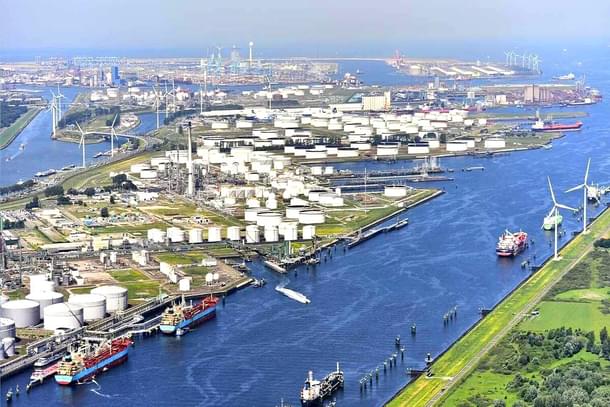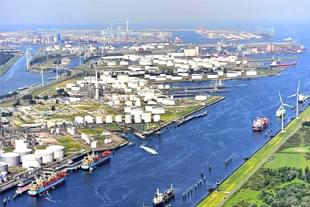Infrastructure
Towards Carbon Neutrality: V O Chidambaranar Port Authority Leases Land For Rs 52,474 Crore Green Hydrogen Project
V Bhagya Subhashini
Jul 24, 2023, 11:35 AM | Updated 11:35 AM IST
Save & read from anywhere!
Bookmark stories for easy access on any device or the Swarajya app.


V O Chidambaranar Port Authority, a state-owned entity responsible for operating the port at Thoothukudi in Tamil Nadu, has granted ACME Cleantech Solutions Pvt Ltd a letter of intent.
This letter allows ACME to lease 222.79 acres of port land for the purpose of establishing a green hydrogen and green ammonia project. The projected investment for this endeavour is Rs 52,474 crore.
The ACME plant is expected to have a daily production capacity of 3,000 tonne of hydrogen. Both ACME and ReNew Power were among the 25 entities that responded to an expression of interest issued by V O C Port Authority regarding the establishment of green hydrogen and green ammonia projects on port land.
V O Chidambaranar Port has achieved a significant milestone by becoming the first port in India to allocate land for the production and export of green hydrogen.
According to Economic Times report, the land will be leased for a period of 30 years, with annual rentals determined by the port authority.
In addition to the agreement with ACME, V O C Port Authority has also leased 10 acres of land to ReNew Power Ltd. This land will be utilised for the storage and export of green hydrogen and ammonia.
The V O C Port Authority is taking initiatives to develop a complete green hydrogen ecosystem for industries and establish itself as India's export hub for green hydrogen, according to a government official.
To ensure round-the-clock availability of sufficient renewable energy for green hydrogen production, the port authority has planned various projects.
These include a 5 MW solar plant, a 2 MW wind farm, a 60 MW hybrid wind solar plant, a mega offshore wind plant, and a desalination plant on a public-private-partnership (PPP) basis, as stated by the official.
In order to support the green hydrogen ambitions of state-owned companies like Indian Oil Corporation Ltd and NTPC Ltd, the port authority is engaging in discussions with them, the official added.
The V O C Port, along with Deendayal Port in Kandla, Gujarat, has been identified by the Ministry of Ports, Shipping, and Waterways as one of the two major ports in the country to house green hydrogen and green ammonia plants.
The ACME facility is set to become one of the largest plants in India and potentially the largest in the world. Its main focus will be on producing green hydrogen and ammonia, which will play a crucial role in de-carbonising various sectors such as fertilisers, power, refining, and steel production.
This ambitious project will consist of a 5,000 MW solar PV plant, a 1.5 GW electrolyzer, and a 1.1 million-tonne ammonia synthesis loop. Together, these components will contribute to the production of green hydrogen and ammonia on a large scale.
ACME has set its sights on becoming one of the world's leading green energy providers by 2030. With a goal to produce 10 million tons per year of green ammonia and hydrogen, this Gurugram-based company is committed to making a significant impact in the renewable energy sector.
ACME has initiated collaborations with governments, partners, and stakeholders to undertake projects in several countries including Oman, India, Egypt, Australia, and Chile.
The company is dedicated to promoting sustainability in challenging sectors such as food, agriculture, steel, shipping, cement, and aluminium.
One of ACME's notable achievements is the establishment of the world's first integrated pilot project for green hydrogen and green ammonia in Bikaner, Rajasthan. The project utilizes 5 MW of solar power and has the potential to scale up to 10 MW, resulting in a reduction of approximately 4,400 tons of CO2 emissions annually.
Additionally, ACME is investing around $5-6 billion to develop a world-scale green hydrogen and green ammonia facility in the special economic zone of Duqm, Oman. This project aims to export green ammonia to demand centers in Europe and Asia.
The facility's initial phase aims to produce 100,000 tonnes of green ammonia annually. It will later be expanded to reach a capacity of 1.2 million tonnes per year, powered by a 5.5 GW solar PV plant and supported by 3.5 GW of electrolyser capacity.
In a significant investment, the Company has signed a Memorandum of Understanding (MOU) with the Karnataka government to establish a green hydrogen and green ammonia project in the state. Additionally, an MoU has been signed with the Odisha government for a similar project in their region.
Green Hydrogen
Hydrogen is a key industrial fuel that has a variety of applications including the production of ammonia (a key fertiliser), steel, refineries and electricity.
The energy industry refers to different 'types' of hydrogen to differentiate how it is produced. Although the production of hydrogen remains primarily 'grey' at the moment, the future of hydrogen is 'green'.
The vast majority of industrial hydrogen is currently produced from natural gas through a conventional process known as steam methane reforming (SMR). The standard SMR process produces what is known as Grey Hydrogen and has the major disadvantage of releasing large quantities of by-product CO2 into the atmosphere — the main culprit for climate change.
Grey hydrogen has increasingly been produced also from coal, with significantly higher CO2 emissions per unit of hydrogen produced so much that it is often called brown or black hydrogen instead of grey.
The diverse pathways to produce hydrogen mean we can produce it using renewable energy sources, such as wind or solar. That makes green hydrogen the cleanest option — hydrogen from renewable energy sources without CO2 as a by-product.
Green hydrogen is defined as hydrogen produced via electrolysis, the splitting of water into hydrogen and oxygen with electricity generated from renewable energy sources such as solar or wind. This is the most environmentally sustainable way of producing hydrogen.
India's Initiatives
To enhance energy security and combat carbon emissions, India has set an ambitious target of producing 5 million tonnes of green hydrogen annually by 2030. Achieving this goal would result in a reduction of approximately 50 million metric tons of carbon emissions and save over $12 billion on fossil fuel imports.
Currently, a majority of the hydrogen consumed in India is produced using fossil fuels. However, with the country's focus on green hydrogen production, this reliance on fossil fuels is expected to decrease significantly in the future.
The government has approved a plan in January to incentivise the production of green hydrogen. This plan aims to cover at least 10 percent of the production cost.
To support the growth of hydrogen manufacturing plants, the government has decided to waive off inter-state transmission fees. However, this exemption only applies to plants that are commissioned before June 2025.
According to a 2022 report titled 'Harnessing Green Hydrogen' by the NITI Aayog and RMI, India's advantage in low-cost renewable energy generation makes green hydrogen the most competitive form of hydrogen in the long run.
The report further highlights that India has the potential to become one of the world's leading producers of green hydrogen. By 2030, green hydrogen can achieve cost parity with natural gas-based hydrogen. Additionally, green hydrogen is crucial for achieving a low carbon economy and reducing dependence on imports for commodities like natural gas and petroleum.
The demand for hydrogen in India is expected to increase more than fourfold by 2050, which would account for nearly 10 percent of the global hydrogen demand.
Based on price parity alone, the share of green hydrogen in this demand could grow from 16 per cent in 2030 to almost 94 per cent by 2050. This would require an estimated electrolyser capacity of 20 GW by 2030 and 226 GW by 2050, presenting a significant opportunity for domestic manufacturing in the emerging global energy technology sector.
The green hydrogen market in India has the potential to reach a cumulative value of $8 billion by 2030 and $340 billion by 2050. The electrolyser market size is projected to be around $5 billion by 2030 and $31 billion by 2050.
Adopting green hydrogen would result in a reduction of 3.6 giga tonne of cumulative CO2 emissions between 2020 and 2050. Additionally, the use of green hydrogen could lead to energy import savings ranging from $246 billion to $358 billion during the same period. Apart from the financial benefits, the report highlights that green hydrogen would enhance energy security, reduce price volatility for Indian industries, and strengthen the country's foreign exchange situation in the long term.
V Bhagya Subhashini is a staff writer at Swarajya. She tracks infrastructure developments.





